
PRIN.OF GENERAL,ORGANIC+BIOLOG.CHEM.
2nd Edition
ISBN: 9781266811852
Author: SMITH
Publisher: MCG
expand_more
expand_more
format_list_bulleted
Concept explainers
Question
Chapter 5, Problem 5.52UKC
(a)
Interpretation Introduction
Interpretation:
The reaction type as endothermic or exothermic reaction from the graph has to be given.
The given graph is,
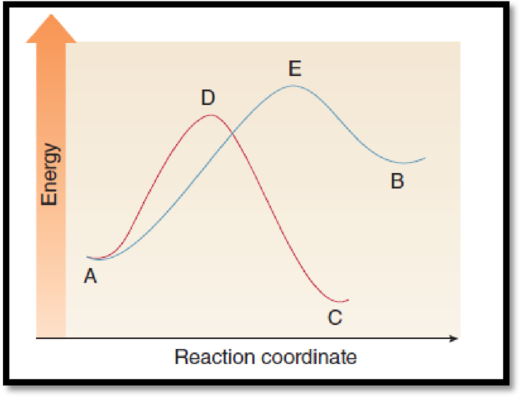
Figure 1
(b)
Interpretation Introduction
Interpretation:
The faster reaction in the graph has to be given.
The given graph is,
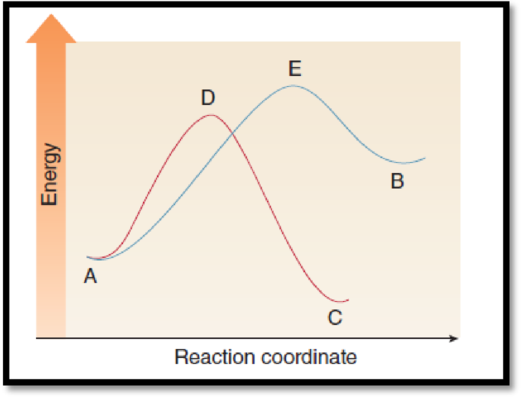
Figure 1
(c)
Interpretation Introduction
Interpretation:
The reaction generates products in lower energy has to be given.
The given graph is,
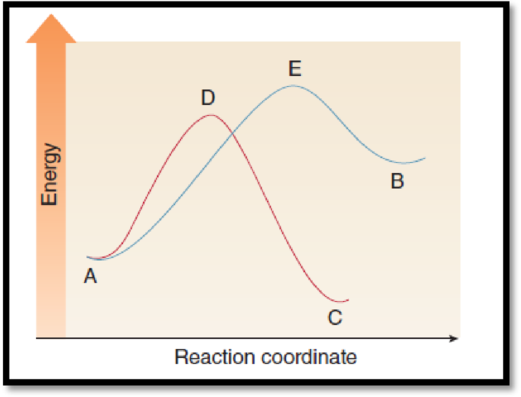
Figure 1
(d)
Interpretation Introduction
Interpretation:
The point on the graph corresponds to the transition state has to be given.
The given graph is,
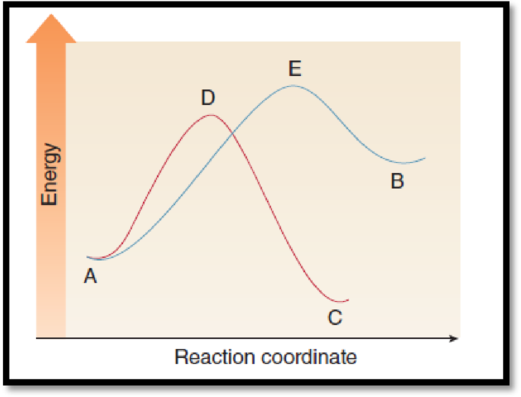
Figure 1
(e)
Interpretation Introduction
Interpretation:
The point corresponds energy of activation has to be given.
The given graph is,
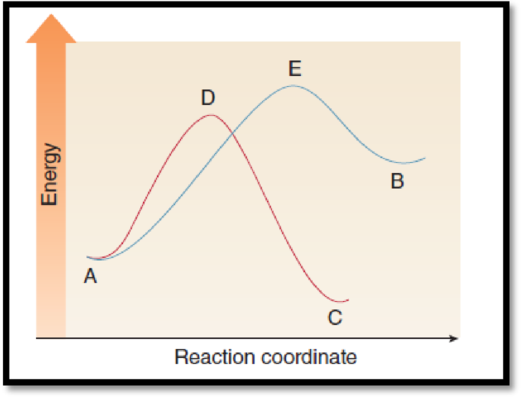
Figure 1
(f)
Interpretation Introduction
Interpretation:
The enthalpy of the reaction has to be given.
The given graph is,
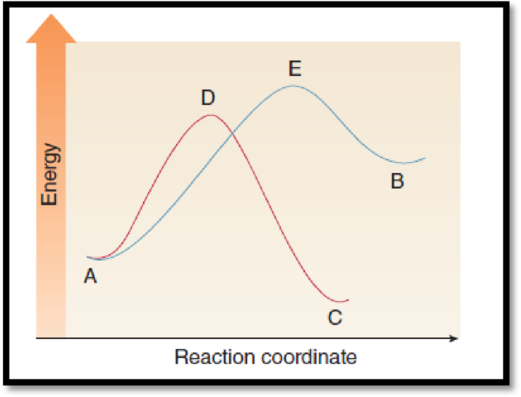
Figure 1
Expert Solution & Answer
Want to see the full answer?
Check out a sample textbook solution
Students have asked these similar questions
. Draw the products for addition reactions (label as major or minor) of
the reaction between 2-methyl-2-butene and with following reactants :
Steps to follow :
A. These are addition reactions you need to break a double bond and make two
products if possible.
B. As of Markovnikov rule the hydrogen should go to that double bond carbon
which has more hydrogen to make stable products or major product.
Here is the link for additional help :
https://study.com/academy/answer/predict-the-major-and-minor-products-of-2-methyl-
2-butene-with-hbr-as-an-electrophilic-addition-reaction-include-the-intermediate-
reactions.html
H₂C
CH3
H H3C
CH3
2-methyl-2-butene
CH3
Same structure
CH3
IENCES
Draw everything on a piece of paper including every single step and each name provided using carbons less than 3 please.
Topics]
[References]
Write an acceptable IUPAC name for the compound below. (Only systematic names, not common names are accepted by this question.)
Keep the information page open for feedback reference.
H
The IUPAC name is
Chapter 5 Solutions
PRIN.OF GENERAL,ORGANIC+BIOLOG.CHEM.
Ch. 5.1 - Use the molecular art to identify the process as a...Ch. 5.1 - Use the molecular at to identify the process as a...Ch. 5.1 - Prob. 5.3PCh. 5.1 - Prob. 5.4PCh. 5.1 - Write a chemical equation from the following...Ch. 5.2 - Prob. 5.6PCh. 5.2 - Prob. 5.7PCh. 5.2 - Prob. 5.8PCh. 5.2 - Prob. 5.9PCh. 5.2 - Prob. 5.10P
Ch. 5.3 - Prob. 5.11PCh. 5.3 - Prob. 5.12PCh. 5.3 - How many molecules are contained in each of the...Ch. 5.3 - Prob. 5.14PCh. 5.4 - Prob. 5.15PCh. 5.4 - Prob. 5.16PCh. 5.4 - Prob. 5.18PCh. 5.4 - Prob. 5.19PCh. 5.5 - Use the balanced equation for the reaction of N2...Ch. 5.5 - Prob. 5.21PCh. 5.6 - Using the balanced equation for fermentation...Ch. 5.6 - Prob. 5.23PCh. 5.6 - Prob. 5.24PCh. 5.6 - Prob. 5.25PCh. 5.7 - Prob. 5.26PCh. 5.7 - Prob. 5.27PCh. 5.7 - Prob. 5.28PCh. 5.7 - Early pacemakers generated an electrical impulse...Ch. 5.8 - Prob. 5.30PCh. 5.8 - Prob. 5.31PCh. 5.8 - Prob. 5.32PCh. 5.8 - Prob. 5.33PCh. 5.9 - Prob. 5.34PCh. 5.9 - Prob. 5.35PCh. 5.9 - Prob. 5.36PCh. 5.10 - Prob. 5.37PCh. 5.10 - In which direction is the equilibrium shifted with...Ch. 5 - Use the molecular art to identify the process as a...Ch. 5 - Prob. 5.40UKCCh. 5 - Prob. 5.41UKCCh. 5 - Prob. 5.42UKCCh. 5 - Prob. 5.43UKCCh. 5 - Prob. 5.44UKCCh. 5 - Prob. 5.45UKCCh. 5 - Spinach, cabbage, and broccoli are excellent...Ch. 5 - Prob. 5.47UKCCh. 5 - Prob. 5.48UKCCh. 5 - Prob. 5.49UKCCh. 5 - Rechargeable nickelcadmium batteries are used in...Ch. 5 - Prob. 5.51UKCCh. 5 - Prob. 5.52UKCCh. 5 - Prob. 5.53UKCCh. 5 - Prob. 5.54UKCCh. 5 - Prob. 5.55APCh. 5 - Prob. 5.56APCh. 5 - Prob. 5.57APCh. 5 - Prob. 5.58APCh. 5 - Prob. 5.59APCh. 5 - Prob. 5.60APCh. 5 - Prob. 5.61APCh. 5 - Prob. 5.62APCh. 5 - Prob. 5.63APCh. 5 - Consider the reaction, 2 NO + 2 CO N2 + 2 CO2....Ch. 5 - Prob. 5.65APCh. 5 - Prob. 5.66APCh. 5 - Prob. 5.67APCh. 5 - Prob. 5.68APCh. 5 - Prob. 5.69APCh. 5 - Prob. 5.70APCh. 5 - Prob. 5.71APCh. 5 - Prob. 5.72APCh. 5 - Prob. 5.73APCh. 5 - Prob. 5.74APCh. 5 - Prob. 5.75APCh. 5 - Prob. 5.76APCh. 5 - Prob. 5.77APCh. 5 - Prob. 5.78APCh. 5 - Prob. 5.79APCh. 5 - Prob. 5.80APCh. 5 - Prob. 5.81APCh. 5 - Prob. 5.82APCh. 5 - Prob. 5.83APCh. 5 - Prob. 5.84APCh. 5 - Prob. 5.85APCh. 5 - Prob. 5.86APCh. 5 - Prob. 5.87APCh. 5 - Prob. 5.88APCh. 5 - Prob. 5.89APCh. 5 - Prob. 5.90APCh. 5 - Prob. 5.91APCh. 5 - Prob. 5.92APCh. 5 - Prob. 5.93APCh. 5 - Prob. 5.94APCh. 5 - Prob. 5.95APCh. 5 - Prob. 5.96APCh. 5 - Prob. 5.97APCh. 5 - Prob. 5.98APCh. 5 - Prob. 5.99APCh. 5 - Prob. 5.100APCh. 5 - Prob. 5.101APCh. 5 - Prob. 5.102APCh. 5 - Prob. 5.103CP
Knowledge Booster
Learn more about
Need a deep-dive on the concept behind this application? Look no further. Learn more about this topic, chemistry and related others by exploring similar questions and additional content below.Similar questions
- [Review Topics] [References] Write an acceptable IUPAC name for the compound below. (Only systematic names, not common names are accepted by this question.) Keep the information page open for feedback reference. The IUPAC name is Submit Answer Retry Entire Group 9 more group attempts remainingarrow_forwardPlease draw.arrow_forwardA chromatogram with ideal Gaussian bands has tR = 9.0 minutes and w1/2 = 2.0 minutes. Find the number of theoretical plates that are present, and calculate the height of each theoretical plate if the column is 10 centimeters long.arrow_forward
- An open tubular column has an inner diameter of 207 micrometers, and the thickness of the stationary phase on the inner wall is 0.50 micrometers. Unretained solute passes through in 63 seconds and a particular solute emerges at 433 seconds. Find the distribution constant for this solute and find the fraction of time spent in the stationary phase.arrow_forwardConsider a chromatography column in which Vs= Vm/5. Find the retention factor if Kd= 3 and Kd= 30.arrow_forwardTo improve chromatographic separation, you must: Increase the number of theoretical plates on the column. Increase the height of theoretical plates on the column. Increase both the number and height of theoretical plates on the column. Increasing the flow rate of the mobile phase would Increase longitudinal diffusion Increase broadening due to mass transfer Increase broadening due to multiple paths You can improve the separation of components in gas chromatography by: Rasing the temperature of the injection port Rasing the temperature of the column isothermally Rasing the temperature of the column using temperature programming In GC, separation between two different solutes occurs because the solutes have different solubilities in the mobile phase the solutes volatilize at different rates in the injector the solutes spend different amounts of time in the stationary phasearrow_forward
- please draw and example of the following: Show the base pair connection(hydrogen bond) in DNA and RNAarrow_forwardNaming and drawing secondary Write the systematic (IUPAC) name for each of the following organic molecules: CH3 Z structure CH3 CH2 CH2 N-CH3 CH3-CH2-CH2-CH-CH3 NH CH3-CH-CH2-CH2-CH2-CH2-CH2-CH3 Explanation Check ☐ name ☐ 2025 McGraw Hill LLC. All Rights Reserved. Terms of Use | Privacy C Garrow_forwardC This question shows how molecular orbital (MO) theory can be used to understand the chemical properties of elemental oxygen O₂ and its anionic derivative superoxide Oz. a) Draw the MO energy diagram for both O2 and O2. Clearly label your diagram with atomic orbital names and molecular orbital symmetry labels and include electrons. Draw the Lewis structure of O2. How does the MO description of O2 differ from the Lewis structure, and how does this difference relate to the high reactivity and magnetic properties of oxygen? ) Use the MO diagram in (a) to explain the difference in bond length and bond energy between superoxide ion (Oz, 135 pm, 360 kJ/mol) and oxygen (O2, 120.8 pm, 494 kJ/mol).arrow_forward
- Please drawarrow_forward-Page: 8 nsition metal ions have high-spin aqua complexes except one: [Co(HO)₁]". What is the d-configuration, oxidation state of the metal in [Co(H:O))"? Name and draw the geometry of [Co(H2O)]? b) Draw energy diagrams showing the splitting of the five d orbitals of Co for the two possible electron configurations of [Co(H2O)]: Knowing that A = 16 750 cm and Пl. = 21 000 cm, calculate the configuration energy (.e., balance or ligand-field stabilization energy and pairing energy) for both low spin and high spin configurations of [Co(H2O)]. Which configuration seems more stable at this point of the analysis? (Note that 349.76 cm = 1 kJ/mol) Exchange energy (IT) was not taken into account in part (d), but it plays a role. Assuming exchange an occur within t29 and within eg (but not between tz, and ea), how many exchanges are possible in the low in configuration vs in the high spin configuration? What can you say about the importance of exchange energy 07arrow_forwardDraw everything please on a piece of paper explaining each steparrow_forward
arrow_back_ios
SEE MORE QUESTIONS
arrow_forward_ios
Recommended textbooks for you
 Chemistry for Engineering StudentsChemistryISBN:9781337398909Author:Lawrence S. Brown, Tom HolmePublisher:Cengage Learning
Chemistry for Engineering StudentsChemistryISBN:9781337398909Author:Lawrence S. Brown, Tom HolmePublisher:Cengage Learning Introductory Chemistry: A FoundationChemistryISBN:9781337399425Author:Steven S. Zumdahl, Donald J. DeCostePublisher:Cengage Learning
Introductory Chemistry: A FoundationChemistryISBN:9781337399425Author:Steven S. Zumdahl, Donald J. DeCostePublisher:Cengage Learning Chemistry for Today: General, Organic, and Bioche...ChemistryISBN:9781305960060Author:Spencer L. Seager, Michael R. Slabaugh, Maren S. HansenPublisher:Cengage Learning
Chemistry for Today: General, Organic, and Bioche...ChemistryISBN:9781305960060Author:Spencer L. Seager, Michael R. Slabaugh, Maren S. HansenPublisher:Cengage Learning- Chemistry: Matter and ChangeChemistryISBN:9780078746376Author:Dinah Zike, Laurel Dingrando, Nicholas Hainen, Cheryl WistromPublisher:Glencoe/McGraw-Hill School Pub Co
 Chemistry In FocusChemistryISBN:9781305084476Author:Tro, Nivaldo J., Neu, Don.Publisher:Cengage Learning
Chemistry In FocusChemistryISBN:9781305084476Author:Tro, Nivaldo J., Neu, Don.Publisher:Cengage Learning Chemistry for Engineering StudentsChemistryISBN:9781285199023Author:Lawrence S. Brown, Tom HolmePublisher:Cengage Learning
Chemistry for Engineering StudentsChemistryISBN:9781285199023Author:Lawrence S. Brown, Tom HolmePublisher:Cengage Learning

Chemistry for Engineering Students
Chemistry
ISBN:9781337398909
Author:Lawrence S. Brown, Tom Holme
Publisher:Cengage Learning

Introductory Chemistry: A Foundation
Chemistry
ISBN:9781337399425
Author:Steven S. Zumdahl, Donald J. DeCoste
Publisher:Cengage Learning

Chemistry for Today: General, Organic, and Bioche...
Chemistry
ISBN:9781305960060
Author:Spencer L. Seager, Michael R. Slabaugh, Maren S. Hansen
Publisher:Cengage Learning

Chemistry: Matter and Change
Chemistry
ISBN:9780078746376
Author:Dinah Zike, Laurel Dingrando, Nicholas Hainen, Cheryl Wistrom
Publisher:Glencoe/McGraw-Hill School Pub Co

Chemistry In Focus
Chemistry
ISBN:9781305084476
Author:Tro, Nivaldo J., Neu, Don.
Publisher:Cengage Learning

Chemistry for Engineering Students
Chemistry
ISBN:9781285199023
Author:Lawrence S. Brown, Tom Holme
Publisher:Cengage Learning